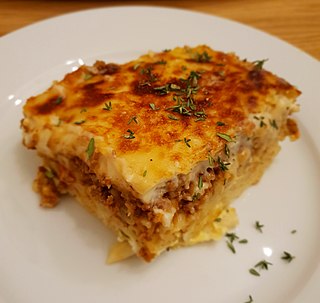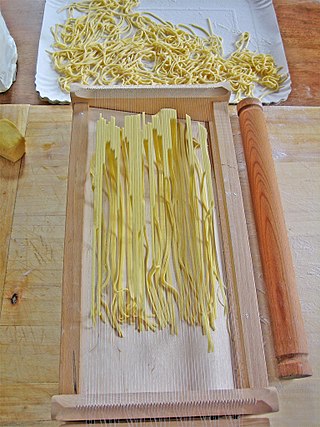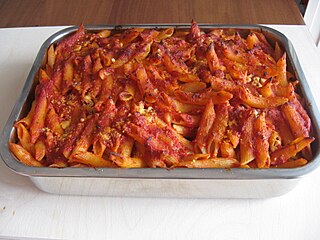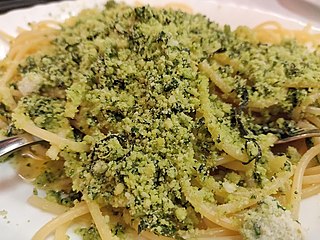
Tomato sauce can refer to many different sauces made primarily from tomatoes, usually to be served as part of a dish, rather than as a condiment. Tomato sauces are common for meat and vegetables, but they are perhaps best known as bases for sauces for Mexican salsas and Italian pasta dishes. Tomatoes have a rich flavor, high water content, soft flesh which breaks down easily, and the right composition to thicken into a sauce when stewed, without the need for thickeners such as roux or masa. All of these qualities make them ideal for simple and appealing sauces.

Carbonara is a pasta dish made with eggs, hard cheese, fatty cured pork, and black pepper. It is typical of the Lazio region of Italy. The dish took its modern form and name in the middle of the 20th century.

Pastitsio is a Greek baked pasta dish with ground meat and béchamel sauce, with variations of the dish found in other countries of the Mediterranean Sea.

In Italian cuisine, ragù is a meat sauce that is commonly served with pasta. An Italian gastronomic society, Accademia Italiana della Cucina, documented several ragù recipes. The recipes' common characteristics are the presence of meat and the fact that all are sauces for pasta. The most typical is ragù alla bolognese. Other types are ragù alla napoletana, ragù alla barese, ragù alla veneta, and so on.

Spaghetti alla puttanesca is an Italian pasta dish invented in Naples in the mid-20th century and made typically with tomatoes, olive oil, olives, anchovies, chili peppers, capers, and garlic, with vermicelli or spaghetti.

Parmigiana, also called parmigiana di melanzane, melanzane alla parmigiana or, in the United States, eggplant parmesan, is an Italian dish made with fried, sliced eggplant layered with cheese and tomato sauce, then baked. The origin of the dish is claimed by the Southern regions of Calabria, Campania, Apulia and Sicily. Other variations found outside Italy may include chicken, veal, or another type of meat cutlet or vegetable filling.

Italian-American cuisine is a style of Italian cuisine adapted throughout the United States. Italian-American food has been shaped throughout history by various waves of immigrants and their descendants, called Italian Americans.

Sugo all'amatriciana or alla matriciana, also known as salsa all'amatriciana, is a traditional Italian pasta sauce based on guanciale, pecorino romano cheese, tomato, and, in some variations, onion. Originating from the town of Amatrice, the amatriciana is one of the best known pasta sauces in present-day Roman and Italian cuisine. The Italian government has named it a traditional agro-alimentary product of Lazio and amatriciana tradizionale is registered as a traditional speciality guaranteed in the EU and the UK.

Orecchiette are a pasta typical of the Apulia region of Italy. Their name comes from their shape, which resembles a small ear.

Bolognese sauce, known in Italian as ragù alla bolognese or ragù bolognese, is a meat-based sauce in Italian cuisine, typical of the city of Bologna. It is customarily used to dress tagliatelle al ragù and to prepare lasagne alla bolognese.

The traditional cuisine of Abruzzo is eclectic, drawing on pastoral, mountain, and coastal cuisine. Staples of Abruzzo cuisine include bread, pasta, meat, fish, cheese, and wine. The isolation which has characterized the region for centuries has ensured the independence of its culinary tradition from those of nearby regions. Local cuisine was widely appreciated in a 2013 survey among foreign tourists.

Spaghetti alla chitarra, also known as maccheroni alla chitarra, is a variety of egg pasta typical of the Abruzzo region of Italy, with a square cross section about 2–3 mm thick. Tonnarelli are a similar pasta from Lazio, used especially in the Roman cacio e pepe. Ciriole, traditionally from Molise, is the thicker version of chitarra, approximately twice the thickness of spaghetti. Because the pasta are cut from a sheet rather than extruded through a die, spaghetti alla chitarra are square rather than round in cross-section.

Pasta al forno or timballo di pasta is a typical dish of Italian cuisine, made of pasta covered with béchamel sauce, tomato sauce and cheese, and cooked in the oven.

Mondeghili, also known as mondeghini), are meatballs typical of Milanese cuisine.

The cuisine of Basilicata, or Lucanian cuisine, is the cuisine of the Basilicata region of Italy. It is mainly based on the use of pork and sheep meat, legumes, cereals and vegetables, with the addition of aromas such as hot peppers, powdered raw peppers and horseradish. The local gastronomy is, for historical-cultural reasons, typically peasant, based on simple recipes and on the culture of reuse, in particular of meat and bread.
Pasta 'ncasciata is a celebratory baked pasta dish originating in the Italian comune (municipality) of Messina, but today there are many versions from every province of Sicily as well as Calabria, in southern Italy. Ingredients vary according to the region as well as personal preferences. For example, while the dish usually uses two types of cheese, béchamel sauce may be used in lieu of one of the cheeses. It was traditionally baked in a dish placed over, as well as covered by, hot coals. The dish was made more well known by Andrea Camilleri's Inspector Montalbano.

Spaghetti alla carrettiera is a pasta dish originating in the Platani Valley, nowadays more common in eastern Sicily. It is generally made with spaghetti, garlic, chili pepper, pecorino siciliano or breadcrumbs, parsley, and olive oil for dressing, and commonly tomato is added. Sometimes additional ingredients such as anchovies, capers, almonds or pine nuts and white wine are also included. The oral tradition is that the pasta dish originated with carters who brought the dish prepared in advance, on their wagons for lunch.


















